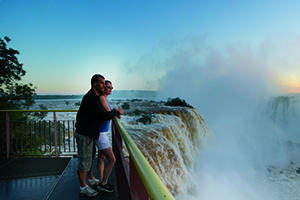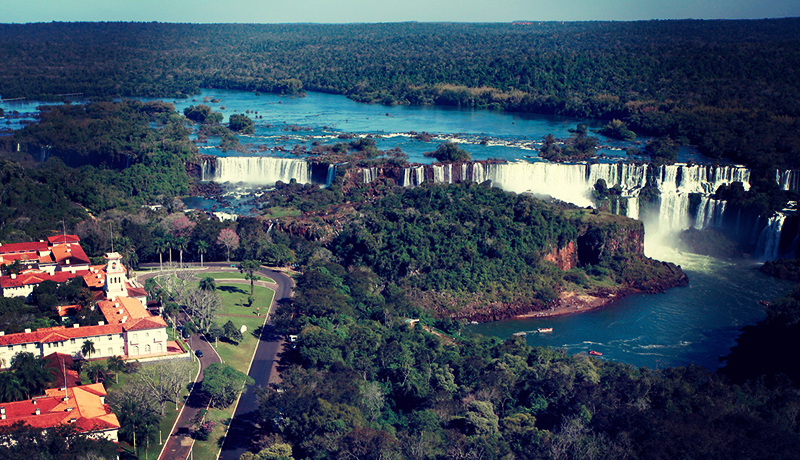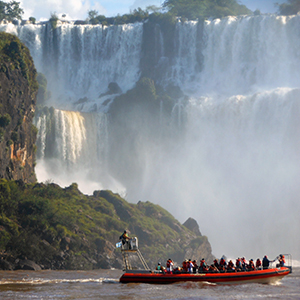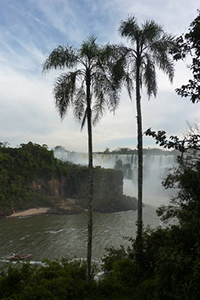

The Breathtaking View Of Iguassu Falls From Brazil’s Belmond Hotel das Cataratas
Photo Courtesy of Belmond Management Limited
To fly into Puerto Iguazú in subtropical northern Argentina is to be dropped into a clearing scratched into the rust-red earth that the dense, ever-encroaching jungle would love to reclaim. Holding the foliage at bay, a small town at the confluence of the Paraná and Iguazú rivers and in close proximity to a huge spectacle: Iguassu Falls, an awe-inspiring wonder that cannot be missed in South America. The town itself is noted most for its proximity to the cataratas (falls), but there is charm to the place — you just have to look for it. Once you’ve checked in — perhaps at the quirky stone and timber Jasy Hotel, the private riverfront cabins of Costa del Sol or even just across Brazil’s border at the luxurious, sprawling Belmond Hotel das Cataratas — head to the seven-street intersection for Codigo Cerveza, which sells individual beers from all of over the southern continent, then spread out your map and plan your attack.

Seeing the Falls by Boat, Photo Courtesy of Xania Woodman
Getting wet
It’s somewhat difficult to get an early start in sleepy, sweltering Puerto Iguazú. Which is all the more reason to do exactly that, and beat the crowds to the gates of Parque Nactional Iguazú, a superbly clean and modern park with trains to transport you from the visitor center to the various trailheads, restaurants and museum. It’s El Garganta del Diablo (the Devil’s Throat) that everyone comes to see from a network of easily navigable steel bridges and paths that take you right along the edges of the falls. The 490-foot-wide waterfall drops nearly 270 feet. Standing at the basalt outcropping where the water suddenly plummets in a frothy plume into the valley and river below, you can’t help but feel the awesome power and deafening roar of the tumbling waters. Fact: The mist rises hundreds of feet above the falls, and comes down the falls like rain — you will get a little wet. If you wish for a more intimate encounter with the falls, you can also take an Iguazú Jungle speedboat from beneath and roar right up to the plunge for “the blessing” (read: drenching). Find the dock on the Lower Circuit trail. Don’t worry if you didn’t come dressed for a complete immersion; you can pick up flip-flops (as well as sunscreen, bug spray and ponchos) at souvenir stalls throughout the park. And when you are about to get on the boat, you receive a dry bag for your belongings.

The Falls From Afar, Photo Courtesy of Phillipp Schinz
Staying dry
Not everyone wants to receive the blessing, but that’s not to say that there isn’t anything else to do here. The UNESCO World Heritage Site that was home to the Eldoradense 10,000 years ago, and later the Guarani (who named the falls “Yguasu,” or “large water”), is also where you’ll find jaguars, jaguarundis, ocelots and the mischievous, sometimes aggressive coatis. After checking out the immense falls from a distance on the Upper Circuit, enjoy the jungle on interpretive trails such as the Lower Circuit and the Macuco Trail, where you can spot smaller (but still exquisite) waterfalls and take a leisurely ecological tour by inflatable boat with a guide trained at pointing out the local flora and fauna.
Trading sides
There are two sides to every river and, therefore, two sides to the falls! Foz do Iguaçu is the Brazilian answer to Puerto Iguazú, a small city from which you can easily get to Parque Nacional do Iguaçu. While 80 percent of the falls are in Argentina, the comparatively small Brazilian park offers a climbing and rappelling course, eco walks, dirt biking, kayaking, helicopter tours, transportation by limited-emission double-deck buses and its own stunning vantage point to observe El Garganta del Diablo. Just remember: U.S. passport holders will need to pay for and print out a visa document before arriving at the border to cross into Brazil, even for just a daytrip to see how the other side falls.
